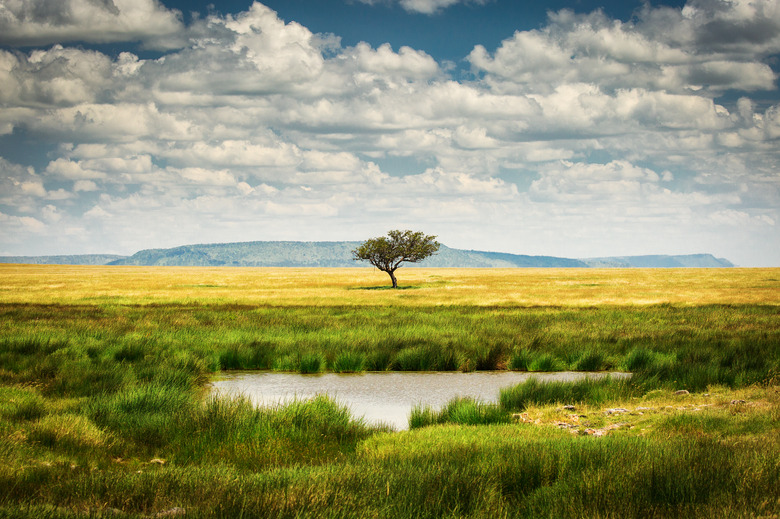What Is A Grassland Biome?
A biome is an area in the Earth's biosphere that is defined by the animals and plants that live within it. These organisms are largely dependent on the environment that they live in, so biomes are also often classified by environmental factors like temperature, weather, climate, precipitation and more.
It's generally accepted that there are five major types of biomes with subtypes within those general classifiers. These five biomes are aquatic, forest, desert, tundra and grassland.
The grassland biome can be found on every continent except Antarctica and is largely defined by grasses as the dominant plant type in the environment, as the name suggests. Grasslands can also be further classified into savannas, steppes and temperate grasslands.
Grassland Definition
Grassland Definition
Grassland biomes are areas that are continuously dominated and covered by various grass species. This is usually the result of the perfect amount of precipitation that allows root plants like grasses to grow and thrive while still not being enough for larger plants like trees to dominate the area.
Because this biome is so widespread in many sorts of locations around the world, there are further subdivisions that can more accurately describe each grassland area.
Types of Grasslands
Types of Grasslands
There are three general subdivisions of grasslands are savannas, temperate grasslands and steppes. Each of these are defined by their rainfall, location, temperature and other defining characteristics.
Savanna Type
Savanna Type
Savannas are a type of tropical grassland. In general, a habitat that consists of grasslands with sparse trees is considered to be a savanna. Warm all year round, this grassland is characterized by distinct wet and dry seasons. The temperatures range from 68° to 86°F with annual rainfall averaging 10 to 30 inches.
The wet season lasts 6-8 months while the dry season is shorter at 4-6 months. The longer season of more consistent moisture and rain allows a few shrubs and even trees to survive in this environment. However, it's still not enough moisture for shrubs or trees to overtake the dominant grasses. Savannas are mostly found in Africa covering about half of the entire continent. They're also found in South America, India and some parts of Australia.
Temperate Grasslands
Temperate Grasslands
Temperate grasslands are also often referred to as prairies or plains. They're most famously found in the Midwestern and western United States, known as the Great Plains. These prairies can also be found in southeast South America, the Manchurian Plain, parts of Russia and in Eastern Europe (Hungary and Romania in particular).
Unlike savannas, shrubs and trees cannot survive here. Annual precipitation here is 20-35 inches. However, much of this is snow that falls in the winter, so the increase in precipitation doesn't allow for trees and shrubs to grow as they might in other areas with this type of rainfall.
Temperatures fluctuate much more than in savannas. Average summer temperatures spike up to over 100°F and winter temperatures easily fall to -40°F.
Steppes Type
Steppes Type
Steppes are also a type of temperate grassland. Steppes have distinct seasons that are warm to hot in the spring/summer and very cold in the winter. They're drier than prairies with 10-20 inches of precipitation each year. Steppes are the rarest type of grassland and are often grouped together under the general term of temperate grassland.
Most steppes are located in Russia and parts of Eastern Europe with some small areas of steppe grasslands in Australia and Sudan.
Grassland Organisms
Grassland Organisms
Grassland plants, as you could guess, are predominantly grass species. Specific species will depend on the type of grassland you're in, but here are some common types in both tropical and temperate grasslands:
- Purple needle-grass
- Blue grama
- Buffalo grass
- Red oat grass
- Rhodes grass
- Elephant grass
- Lemon grass
Trees and shrubs of the savanna include the baobab, umbrella acacia, river bushwillow and raisin bush.
Grassland animals of the savanna include zebra, gazelle, antelope, cheetah, lions, elephants, various species of snakes, lizards, starlings, weavers and more. Temperate grassland animals include bison, wild horses, prairie dogs, coyotes, falcons, various species of insects and gophers.
References
Cite This Article
MLA
Walsh, Elliot. "What Is A Grassland Biome?" sciencing.com, https://www.sciencing.com/grassland-biome-6304879/. 22 November 2019.
APA
Walsh, Elliot. (2019, November 22). What Is A Grassland Biome?. sciencing.com. Retrieved from https://www.sciencing.com/grassland-biome-6304879/
Chicago
Walsh, Elliot. What Is A Grassland Biome? last modified March 24, 2022. https://www.sciencing.com/grassland-biome-6304879/
